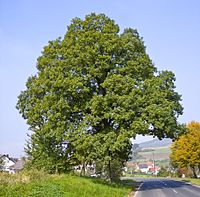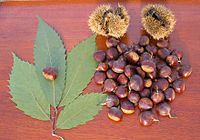
Balancing selection at nonself recognition loci in the chestnut blight fungus, Cryphonectria parasitica, demonstrated by trans-species polymorphisms, positive selection, and even allele frequencies
Sign Up to like & getrecommendations! Published in 2018 at "Heredity"
DOI: 10.1038/s41437-018-0060-7
Abstract: Balancing selection has been inferred in diverse organisms for nonself recognition genes, including those involved in immunity, mating compatibility, and vegetative incompatibility. Although selective forces maintaining polymorphisms are known for genes involved in immunity and… read more here.
Keywords: vegetative incompatibility; nonself recognition; parasitica; balancing selection ... See more keywords

Cryphonectria parasitica, the causal agent of chestnut blight: invasion history, population biology and disease control.
Sign Up to like & getrecommendations! Published in 2018 at "Molecular plant pathology"
DOI: 10.1111/mpp.12542
Abstract: Chestnut blight, caused by Cryphonectria parasitica, is a devastating disease infecting American and European chestnut trees. The pathogen is native to East Asia and was spread to other continents via infected chestnut plants. This review… read more here.
Keywords: chestnut; control; disease; biology ... See more keywords

In-Tree Behavior of Diverse Viruses Harbored in the Chestnut Blight Fungus, Cryphonectria parasitica
Sign Up to like & getrecommendations! Published in 2020 at "Journal of Virology"
DOI: 10.1128/jvi.01962-20
Abstract: The ascomycete Cryphonectria parasitica causes destructive chestnut blight, which is controllable by hypovirulence-conferring viruses infecting the fungus. The tripartite chestnut/C. parasitica/virus pathosystem involves the dynamic interactions of their genetic elements, i.e., virus transmission and lateral… read more here.
Keywords: chestnut blight; chestnut; hypovirulence; cryphonectria parasitica ... See more keywords

New finds of Cryphonectria parasitica and the first record of chestnut blight on red oak Quercus rubra L. in the Czech Republic.
Sign Up to like & getrecommendations! Published in 2018 at "Journal of forest science"
DOI: 10.17221/4561-jfs
Abstract: The causal agent of the chestnut blight, the fungus Cryphonectria parasitica (Murrill) M. E. Barr (syn. Endothia parasitica (Murrill) P. J. Anderson et H. W. Anderson), was found out at new localities in the Czech… read more here.
Keywords: oak quercus; red oak; czech republic; chestnut blight ... See more keywords

Management of Chestnut Blight in Greece Using Hypovirulence and Silvicultural Interventions
Sign Up to like & getrecommendations! Published in 2018 at "Forests"
DOI: 10.3390/f9080492
Abstract: Sweet chestnut (Castanea sativa Mill.) is an important tree for Greece. The invasive fungus Cryphonectria parasitica, which causes chestnut blight, was first found in Central Greece in 1963. It has since spread all over the… read more here.
Keywords: chestnut; hypovirulence; silvicultural interventions; hypovirulence silvicultural ... See more keywords

Temperature Effects on the Cryphonectria hypovirus 1 Accumulation and Recovery within Its Fungal Host, the Chestnut Blight Pathogen Cryphonectria parasitica
Sign Up to like & getrecommendations! Published in 2023 at "Viruses"
DOI: 10.3390/v15061260
Abstract: Biological control of Cryphonectria parasitica fungus, the causal agent of chestnut blight, by virus infection (hypovirulence) is an effective control strategy against chestnut blight in Europe and some parts of North America. The most studied… read more here.
Keywords: temperature; cryphonectria parasitica; chestnut blight; cryphonectria hypovirus ... See more keywords